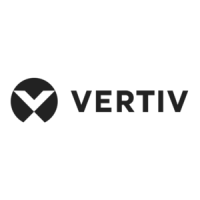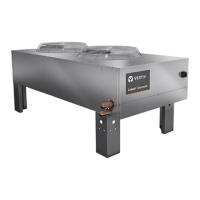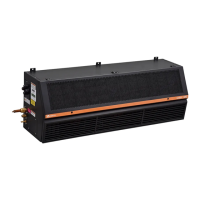Vertiv | Liebert PEX+Chilled Water | User Manual 68
iCOM Controller Operation
• Teamwork Mode 2: Unbalanced load (large rooms, not all units will have the same load) (work well for most
applications)
Teamwork Mode 2 is designed to prevent units within a group from working against each other or “fighting”. It is
best applied in large rooms with unbalanced heat loads. In Teamwork Mode 2, all parameters are shared equal to
Mode 1, and Unit #1 averages all of the available unit sensor readings on the network to define whether there is
a cooling, heating, dehumidification or humidification request. If there is a cooling request, all units are released
to start cooling resources according to their own temperature readings; heating is disabled for all units and vice
versa. Same for humidity control.
If the network average would ask for 0% proportional band, the most demanding request (highest or lowest
temperature of all units, highest or lowest humidity of all units) would be used to define the operation to be
performed.
Teamwork Mode 2 does not rotate the cooling source; unevenly distributed working hours to be expected. Auto
set will not adjust the proportional band in this mode.
• Teamwork Mode 3 (Smart Team):
Teamwork Mode 3 can be selected when the units are set to operate in Smart Aisle Control mode and have been
connected in a unit-to-unit network. Teamwork provides coordination between the units to prevent the “fighting”
among th units in the network by not allowing units to operate in conflicting modes at the same time. This
conflict may arise due to mode selection based on the average of the collective unit sensors (Cooling vs. Heating
and Humidifying vs. Dehumidifying).
Teamwork Mode 3 allows the cooling capacity (Supply Sensor) to operate as a local control by removing only the
amount of load required to maintain the discharge air temperature at each unit. This allows for an unbalanced
room load while maintaining a consistent discharge air temperature. The fan speed is controlled by the remote
rack sensors of all units, providing a controlled delivery method of the air to the cold aisle. In raised floor
applications, all units will share sensor information to achieve even underfloor air distribution. This distribution is
achieved by operating all fans in parallel that will also provide the highest energy eiciency.
Figure 4-11 shows the dierence in both underfloor air distribution and energy consumption when Variable Fan
speed and Teamwork Mode 3 are applied to the Liebert Precision Cooling units. The example on the left is using
the standard standby configuration; the example on the right is utilizing Teamwork Mode 3. The units below are
assuming that the fan power consumed at each unit is 8.1 kW when operating at 100%.

